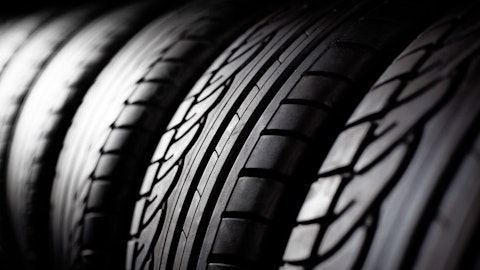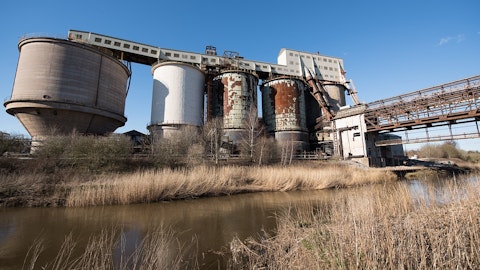Eastman Chemical Company (NYSE:EMN) Q3 2023 Earnings Call Transcript October 27, 2023
Operator: Good day, everyone, and welcome to the Third Quarter 2023 Eastman Conference Call. Today’s conference is being recorded. This call is being broadcast live on the Eastman’s website www.eastman.com. We will now turn this call over to Mr. Greg Riddle of Eastman, Investor Relations. Please go ahead, sir.
Greg Riddle: Thank you, Jordan. Good morning, everyone, and thank you for joining us. On the call with me today are Mark Costa, Board Chair and CEO; William McLain, Executive Vice President and CFO; and Jake LaRoe, Manager, Investor Relations. Yesterday after market closed, we posted our third quarter 2023 financial results news release and SEC 8-K filing. Our slides and the related prepared remarks in the Investors section of our website, which is www.eastman.com. Before we begin, I’ll cover two items. First, during this presentation, you will hear certain forward-looking statements concerning our plans and expectations. Actual events or results could differ materially. Certain factors related to our future expectations are or will be detailed in our third quarter 2023 financial results news release, during this call, in the preceding slides and prepared remarks and in our filings with the Securities and Exchange Commission, including the Form 10-K filed for full-year 2022 and the Form 10-Q to be filed for third quarter 2023.

A close up of a laboratory beaker filled with colorful chemicals, signifying the company’s specialty chemicals.
Second earnings referenced in this presentation exclude certain non-core and unusual items. Reconciliations to the most directly comparable GAAP financial measures and other associated disclosures, including a description of the excluded and adjusted items are available in the third quarter 2023 financial results news release. As we posted the slides an accompanying prepared remarks on our website last night, we will now go straight into Q&A. Jordan, please let’s start with our first question.
See also Jim Cramer’s 14 Best of Breed Stocks and 20 States with the Highest Alcohol and Beer Tax.
Q&A Session
Follow Eastman Chemical Co (NYSE:EMN)
Follow Eastman Chemical Co (NYSE:EMN)
Operator: Thank you. [Operator Instructions] Our first question comes from David Begleiter of Deutsche Bank. David, the line is yours.
David Begleiter: Thank you, good morning. Mark, thanks for the comments on 2024 in the prepared comments. Can you provide a little more color on the potential you think for 2024 earnings in this macro?
Mark Costa: Sure, David. And a great question. We’re obviously spending a lot of time focusing on putting this year behind us and focusing how we recover and deliver a lot of earnings and growth next year. When you think about it in the way we built our forecast or, if you will, a scenario, was to intentionally be somewhat neutral on where markets recover or don’t recover or what oil prices or energy prices can do. So we wanted sort of a neutral case to focus first on what are the things that are more in control or math that deliver a better year next year than this year. And the biggest driver, of course, in the decline in earnings this year was volume and mix. And when you look at the extent of that across the portfolio, we’re probably down about $450 million in volume and mix from a variable margin point of view, excluding capacity utilization.
And then, as we look at how that can recover next year, we sort of think of it in three buckets. The first is, obviously, a lack of destocking. There’s a lot of conversation around that. And it was certainly a very significant element to our business. And we generally think destocking was probably about 40% of the decline in volume this year. But let’s be conservative and call that sort of one-third comes back next year from destocking. So $150 million there on variable margin. And that’s just a lack of destocking. So it doesn’t include restocking, it doesn’t include any markets getting better. The second element is innovation. We are very excited about our innovation portfolio. It’s been the center of our growth story as a company. And the biggest element, of course, will be the Kingsport methanolysis plant coming online, delivering an incremental $75 million in EBITDA to next year relative to this year.
And that’s all in with costs and revenue and margins considered. So that’s pretty considerable. So you’ve got that on top of the lack of destocking. And then you’ve got innovation that’s happening across our portfolio. It’s not just Kingsport and methanolysis. We’ve had great success with premium interlayers delivering a lot of value with the growth in the automotive market and extreme leverage of 3.5 times the material per car in EVs versus ICE cars. So that’s a great business and we’ll continue to deliver above market growth. We’ve got the Aventa products we’ve been telling you about where we’ve had great success, [adoptions and straws] (ph) and some brands going national as well as now, making great progress in our polystyrene replacement for protein packaging and food packaging, et cetera.
And you’re going to see some real nice growth out of that business. The Naia textile business has been great this year and will continue to touch your shields, picking up more business and food cans, and we’re starting to move into the beverage side. So there’s a lot of growth happening throughout the portfolio through innovation, even in a flat market. And we’re going to see more benefit really next year when you’re in a more stable market situation and people are focusing on new launches. The third element, of course, is the markets. And as you saw in our guidance, we’re being pretty cautious about where the markets might go. I think there’s lots of debate around markets could recover, markets could go down. I think it’s fair to say none of us really know.
But I think it’s reasonable to expect that our stable markets will probably stabilize because the end market demand there is sort of not as discretionary. So pharma, personal care, packaging for food, those kind of markets are all going to stabilize. Medical probably have some modest growth when you look at those dynamics. Automotive is expected to grow, and we think that’s a reasonable assumption. Building construction we think is flat to down a little bit. So when you put all this together, you’ve got some additional volume growth out of that on top of those numbers from destocking and Kingsport methanolysis. So considerable value there. The second part is asset utilization. So we’ve been extremely aggressive in managing our assets and pulling the utilization rates down to free up cash.
We saw great success in over $500 million of cash generated in the third quarter by the actions we took. Unfortunately, it comes with a counting headwind. It’s not a cash headwind, but you take a $75 million utilization headwind hit in the third quarter alone for that or $75 million really on a full year basis when you think about the tailwind for next year. So you get to add that back if volumes are flat that comes back. Obviously, there’s actions we’re taking to keep our cost structure flat. So all that revenue growth we’re talking about above in the volume side of things flows straight to the bottom line. So the incremental margins on the recovery are going to be quite strong. So all that creates a good situation. Offsetting that could be especially pricing starting to moderate in a few places.
We still have a lot of raw material in inventory that is lower and still needs to flow through. We’re about 50% FIFO in our company. So you’re going to see some benefits of that flowing through into next year that will sort of offset, especially pricing. So we don’t really see raw materials as a tailwind, but we also don’t really see it as much of a headwind. So all those factors put together, delivers quite a bit of improvement in earnings and earnings from — our operating in the cash side as well. So we’re pretty excited about focusing on all these actions that we can control on this uncertainty and delivering success for our owners.
David Begleiter: Very, very helpful. And just lastly, in the areas where you are still seeing destocking like crop protection, when do you think it will end or how long do you think it will persist? Thank you.
Mark Costa: On the ag market, which is more than crop protection, but a number of different products. Obviously, the destocking didn’t start until the second quarter of this year. Very different timing stories like consumer durables or building construction started aggressively in the fourth quarter of last year, but ag didn’t start until the second quarter. So the destocking started, it got more aggressive from the second to the third quarter. And it continues into the fourth quarter. We do think it’ll be played out by the end of the fourth quarter from what our customers are telling us as they start looking to the next planting season. But normally you’d have a build-in inventory starting in the fourth quarter and through the first quarter for the planning season.
This year, we’re going to see destocking through the fourth quarter and then a ramp up of building inventory in the first quarter of next year. So that’s part of that headwind relative to what is “normal” for a fourth quarter is that delta between building versus pretty aggressive destocking.
David Begleiter: Thank you very much.
Operator: Our next question comes from Frank Mitsch of Fermium Research. Frank, please go ahead.





